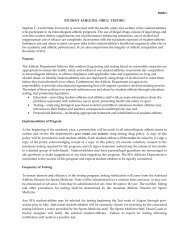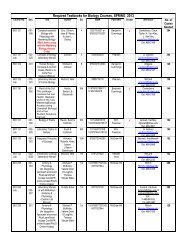'From ADHD Rating Scale-IV: Checklists, Norms and ClinicillInmpmation. Reprinted with permiSSion ofThe Guilford Press: New York. {;)1998 George J. DuPaul, Thomas J. Power, Arthur A. Anas<strong>to</strong>poulos and Robert Reid. This scale may not be reproduced in any form withoutwritten permission ofThe Guilrord Press. www.guilford.comtprompts developed by Lenard Adler, MD, Thomas Spencer, MD, and Joseph Biederman, MD.{;)2003 New York University and Massachusetts General Hospital. All rights reserved, DO NOT REPRODUCE W'lTHOUT WRITIEN PERMISSION 01' MASSACHUSETIS GENERAL HOSPITAL OR NEW YORK UNIVERSITY.THERE ARE NO WARRANTIES REGARDING THIS ATTENTION DEFICIT HYPERACTIVITY DISORDER RATING SCALE IVAND ADULT PROMPTS ("SCALE"), EXPRESS OR IMPLIED, INCLUDING WITHour LIMITATION, IMPLIED WARRANTIESOF MERCHANTABILITY AND FITNESS FOR A PARTICULAR PURPOSE, AND ALL OTHER REPRESENTATIONS OR WARRANTIES 01' ANY KIND ARE HEREBY DISCLAIMED. New York Universiry and rhe Massachusetts General Hospital shall neitherexercise comrol over nor incerfere with the physician-patient relationship of users of this Scale and shaJj not be responsible for any use made of this Scale, including any medical decisions regarding the care and treatment of patients using the Scale.ADHD 502 04/0810. Squirms and fidgetsCan you sit still or are you always moving yourhands or teet, or fidgeting in your chair?Do you tap your pencil or your feet? A lot? Do peoplenotice?AdultADHD-RS-IV* with Adult Prompts fNone Mild Moderate Severe0 1 2 315. Talks excessivelyDo you talk a lot? All the time? More than other people?Do people complain about your talking? Is it a problem?Are you often louder than the people you are talking <strong>to</strong>?None Mild Moderate Severe0 1 2 3Do you regularly play with your hair or clothing? 16. Blurts out answers 0 1 2 3Do you consciously resist fidgeting or squirming?Do you give answers <strong>to</strong> questions before someonefinishes asking?11. Can't stay seated0 1 2 3Do you say things before it is your turn?Do you have trouble staying in your seat? At work?Do you say things that don't fit in<strong>to</strong> the conversation?In class? At home (eg, watching TV, dinner)?Do you do things without thinking? A lot?In church or temple?Do you choose <strong>to</strong> walk around rather than sir? 17. Can't wait for tum 0 1 2 3Do you have <strong>to</strong> force yourself <strong>to</strong> remain seated?Is it hard for you <strong>to</strong> wait your rum (in conversation,Is ir difficult for you <strong>to</strong> sit through a long meetingin lines, whileor lecture?Are you frequently frustrated with delavs? Does itDo you try <strong>to</strong> avoid going <strong>to</strong> functions rhat requirecause problems?you <strong>to</strong> sit still for long periods of time?Do you put a great deal ofeffort in<strong>to</strong> planning <strong>to</strong> not be in12. Runs/climbs excessively 0 1 2 3situations where you might have <strong>to</strong> wait?Are you physically restless? 18. Intrudes/interrupts others 0 1 2 3Do you feel restless inside? A lor?Do you talk when others are talking, without waiting untilDo you feel more agitated when you cannot exerciseyou are acknowledged?on an almost daily basis?Do you butt in<strong>to</strong> others' conversations before being invited?Do you interrupt others' activities?13. Can't play/work quiedy0 1 2 3Is it hard for you <strong>to</strong> wait <strong>to</strong> get your point across inDo you have a hard time playing/working quiedy?conversations or atleisure activity (nonstrucrured times or onyour own such as a book, listening <strong>to</strong> music,a board game), are you agitated orDo you always need <strong>to</strong> be busy after work or while onvacation?14. On the go, "driven by a mo<strong>to</strong>r" 0 1 2 3Is it hard for you <strong>to</strong> slow down?Do you feel like you (often) have a lot of energyand that you always have [0 be moving, are always"on the go"?Do you feel like you're driven by a mo<strong>to</strong>r?Do you feel unable <strong>to</strong> relax?
Adult ADHD Self-Report Scale (ASRS-v1.1) Symp<strong>to</strong>m ChecklistInstructionsThe questions on the back page are designed <strong>to</strong> stimulate dialogue between you and your patients and <strong>to</strong> helpconfirm if they may be suffering from the symp<strong>to</strong>ms of attention-deficit/hyperactivity disorder (ADHD).Description: The Symp<strong>to</strong>m Checklist is an instrument consisting of the eighteen DSM-IV-TR criteria.Six of the eighteen questions were found <strong>to</strong> be the most predictive of symp<strong>to</strong>ms consistent withADHD. These six questions are the basis for the ASRS v1.1 Screener and are also Part A of theSymp<strong>to</strong>m Checklist. Part B of the Symp<strong>to</strong>m Checklist contains the remaining twelve questions.Instructions:Symp<strong>to</strong>ms1. Ask the patient <strong>to</strong> complete both Part A and Part B of the Symp<strong>to</strong>m Checklist by marking an Xin the box that most closely represents the frequency of occurrence of each of the symp<strong>to</strong>ms.2. Score Part A. If four or more marks appear in the darkly shaded boxes within Part A then thepatient has symp<strong>to</strong>ms highly consistent with ADHD in adults and further investigation iswarranted.3. The frequency scores on Part B provide additional cues and can serve as further probes in<strong>to</strong> thepatient’s symp<strong>to</strong>ms. Pay particular attention <strong>to</strong> marks appearing in the dark shaded boxes. Thefrequency-based response is more sensitive with certain questions. No <strong>to</strong>tal score or diagnosticlikelihood is utilized for the twelve questions. It has been found that the six questions in Part Aare the most predictive of the disorder and are best for use as a screening instrument.Impairments1. Review the entire Symp<strong>to</strong>m Checklist with your patients and evaluate the level of impairmentassociated with the symp<strong>to</strong>m.2. Consider work/school, social and family settings.3. Symp<strong>to</strong>m frequency is often associated with symp<strong>to</strong>m severity, therefore the Symp<strong>to</strong>mChecklist may also aid in the assessment of impairments. If your patients have frequentsymp<strong>to</strong>ms, you may want <strong>to</strong> ask them <strong>to</strong> describe how these problems have affected the ability<strong>to</strong> work, take care of things at home, or get along with other people such as theirspouse/significant other.His<strong>to</strong>ry1. Assess the presence of these symp<strong>to</strong>ms or similar symp<strong>to</strong>ms in childhood. Adults who haveADHD need not have been formally diagnosed in childhood. In evaluating a patient’s his<strong>to</strong>ry,look for evidence of early-appearing and long-standing problems with attention or self-control.Some significant symp<strong>to</strong>ms should have been present in childhood, but full symp<strong>to</strong>mology is notnecessary.





